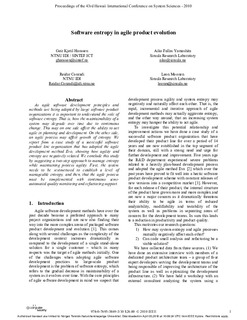| dc.contributor.author | Hanssen, Geir Kjetil | |
| dc.contributor.author | Conradi, Reidar | |
| dc.contributor.author | Yamashita, Aiko Amparo Fallas | |
| dc.contributor.author | Moonen, Leon | |
| dc.date.accessioned | 2017-11-14T10:15:23Z | |
| dc.date.available | 2017-11-14T10:15:23Z | |
| dc.date.created | 2010-12-26T16:20:56Z | |
| dc.date.issued | 2010 | |
| dc.identifier.citation | Proceedings of the Annual Hawaii International Conference on System Sciences. 2010, 43 . | nb_NO |
| dc.identifier.issn | 1530-1605 | |
| dc.identifier.uri | http://hdl.handle.net/11250/2466113 | |
| dc.description.abstract | As agile software development principles and methods are being adopted by large software product organizations it is important to understand the role of software entropy. That is, how the maintainability of a system may degrade over time due to continuous change. This may on one side affect the ability to act agile in planning and development. On the other side, an agile process may affect growth of entropy. We report from a case study of a successful software product line organization that has adopted the agile development method Evo, showing how agility and entropy are negatively related. We conclude this study by suggesting a two-step approach to manage entropy while maintaining process agility. First, the system needs to be restructured to establish a level of manageable entropy, and then, that the agile process must be complemented with continuous semi-automated quality monitoring and refactoring support. | nb_NO |
| dc.language.iso | eng | nb_NO |
| dc.publisher | Institute of Electrical and Electronics Engineers (IEEE) | nb_NO |
| dc.relation.uri | http://www.idi.ntnu.no/grupper/su/publ/geirkjetil/hicss43-15sep09.pdf | |
| dc.title | Software Entropy in Agile Product Evolution | nb_NO |
| dc.type | Journal article | nb_NO |
| dc.type | Peer reviewed | nb_NO |
| dc.description.version | acceptedVersion | nb_NO |
| dc.source.pagenumber | 10 | nb_NO |
| dc.source.volume | 43 | nb_NO |
| dc.source.journal | Proceedings of the Annual Hawaii International Conference on System Sciences | nb_NO |
| dc.identifier.cristin | 515645 | |
| dc.description.localcode | © 2010 IEEE. Personal use of this material is permitted. Permission from IEEE must be obtained for all other uses, in any current or future media, including reprinting/republishing this material for advertising or promotional purposes, creating new collective works, for resale or redistribution to servers or lists, or reuse of any copyrighted component of this work in other works. | nb_NO |
| cristin.unitcode | 194,63,10,0 | |
| cristin.unitname | Institutt for datateknikk og informasjonsvitenskap | |
| cristin.ispublished | true | |
| cristin.fulltext | postprint | |
| cristin.qualitycode | 1 | |
